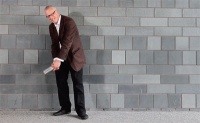Myerson calls for complete rethink on workplace design
Designers are so lucky. They work in hip, happening, humane offices that leave the average visitor seething with envy.
Breakout spaces, natural light, soft furnishings, studio dogs, fridges stacked with booze – even football tables are not unusual where they work. Cut to the standard office and regard the people – nearly as sensitive and creative as they are – parked elbow to elbow at tiny desks, blinking wanly beneath fluorescent lights with nowhere to run to, nowhere to hide except the lavatory stall.
Interior designers, struggle to a sitting position on your beer-soaked bean bags, and listen. The Royal College of Art’s Helen Hamlyn Centre director Jeremy Myerson (pictured below) is calling on you to liberate workers from office designs that no longer suit the way we work.
His new book, New Demographics New Workspace: Office Design for the Changing Workforce (published by Gower Publishing, priced £49.50), was co-authored by anthropologist Jo-Anne Bichard and psychologist Alma Erlich. It is the culmination of a two-year study into workplace design that explores two major trends: an ageing workforce and the growth of ’knowledge’ industries including telecommunications, education, health, financial and business services, and hi-tech manufacturing. Staff in these industries work with ideas rather than objects, for companies that usually claim to value innovation above all.
’Within one office, we need a selection of different spaces to work in for shorter amounts of time, that will accommodate both baby boomers and younger generations,’ says Myerson. He suggests three spaces: an area where people can collaborate, a place where people can work privately and quietly, and somewhere tired workers can rest and recuperate.
Myerson’s vision of day beds, soft furnishings, modular seating systems, fabric drapes and water walls sounds like an idyllic vision doomed to fall at the hurdle of the bottom line.
’This isn’t a fantasy,’ he counters. ’It’s happening now, there is a movement towards it. Companies spend a great deal on office refurbishments, and adding some fabric and dividing the spaces up differently does not cost much more.’
Sevil Peach Architecture & Design has created offices for Microsoft in Amsterdam and Swiss Pharmaceuticals company Novartis (pictured above). Its work on both projects includes spaces for quiet contemplation.
For designers who wish to take up arms against a sea of desks, Peach’s advice is to create a very close dialogue with the client. ’It requires a lot of talking,’ she says. ’We quite often challenge briefs, pushing to create environments that are more people-centred, rather than just stacks of desks, stacks of people. We try to open the client’s mind to the fact that you spend more time in the workplace than at home.’
Rejecting economic barriers to change, Myerson offers a philosophical reason for any resistance to this particular workspace revolution. ’There is a Calvinistic attitude that says work must not be too pleasant, that it is meant to be nasty and brutal, but if you have an older, highly educated workforce doing clever things, then they need to be supported by the environment.’
Innocent Drinks is one of the UK’s most successful businesses. There is no doubting its fiscal nous. And yet its offices in west London look like a playground. Designed largely in-house, they include hanging baskets to hide in, picnic benches and booths to chill out at, as well as your own desk, which ’we encourage staff very much to personalise’, says environment manager Charlie Heavey. Its impending move promises new delights from Stiff & Trevillion.
’People work best in places that accommodate their needs,’ Heavey continues. ’We are trying to make life easier for our staff, but there is no doubting their professionalism. This is a work-hard, play-hard culture, but there are people who work well among music and colours, and there are those who need to stare at a blank wall. We try to understand and accommodate everybody.’

Offices to envy
Aardman Animations, Bristol, by Alec French Architects
Dyson, Malmesbury, by Wilkinson Eyre
Innocent Drinks, London, designed in-house. Jump Studios worked on the mezzanine and final extension
Sony Music, London, by Morey Smith
-
Post a comment




